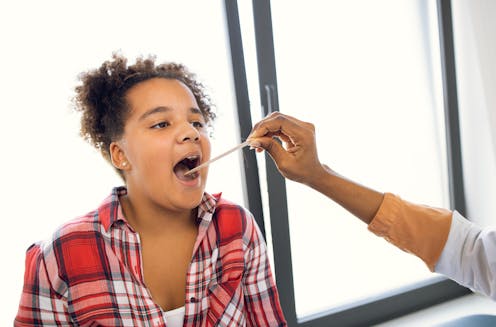Strep A cases are rising. We must remember our earliest hygiene lessons as vaccine trials continue
- Written by Michael Good, Professor and NHMRC Investigator Fellow, Institute for Glycomics, Griffith University

Group A streptococci, also known as “strep A”, were the first organisms ever identified to be the cause of a disease.
In the mid-1800s, Hungarian physician Ignaz Semmelweis first noted the link between a lack of hygienic practices – such as handwashing – among medical staff and puerperal (or childbirth) fever. Louis Pasteur subsequently demonstrated that it was caused by the microbe we now refer to as strep A.
Puerperal fever, a life-threatening condition, is much less common now, but strep A has not gone away. In fact, it is known to cause more types of disease than any other single micro-organism.
And infections appear to be on the rise.
A common organism that can cause everyday and rare illnesses
Strep A organisms commonly live on people and, while they don’t usually cause disease, they can become virulent. Their propensity to cause illness depends on the strain of the organism, the simultaneous presence of other microbes (often viruses), and the level of immunity the person may already have.
The most common diseases caused by strep A are tonsillitis (also called “strep throat”) and impetigo (also known as “school sores”).
These conditions are relatively benign, but if untreated can give rise in some individuals to deadly complications, including “invasive” strep A disease and rheumatic heart disease, which is the most commonly acquired heart disease in people younger than 25.
Other conditions caused by strep A include erysipelas and cellulitis (infections of the skin), glomerulonephritis (inflammation of the kidneys), scarlet fever (named for the red rash it causes) and toxic shock syndrome (which can cause organ failure and death).
Read more: Strep A: three doctors explain what you need to look out for
Rising cases in children
Recently, there is concern because case numbers of invasive streptococcal disease (now a notifiable disease in Australia) are rising, particularly among children.
Invasive disease occurs when an otherwise simple infection of the tonsils or skin spreads beyond the local tissue and invades deep tissue. From there it can spread to distant sites in the body, leading to shock, potential loss of limbs, and death.
Although cases are on the rise in multiple countries, the chances of an individual case of strep throat progressing to invasive disease are low. Worldwide there is an estimated incidence of around 700 million cases of tonsillitis or school sores every year, of which about 1 in 1,000 lead to invasive disease.
The reason for the recent jump in case numbers of invasive disease is unclear.
A new strain may be responsible but this needs more investigation. We know there are hundreds of strains of strep A.
In the United Kingdom, which has also seen a significant rise in cases, a few strains seem to dominate. But these same strains have been circulating in the community for several years.
Read more: What are school sores and how do you get rid of them?
Is it because of lockdowns?
It seems likely, both in the UK and here, that the main reason we are seeing more cases now is because we are experiencing more respiratory infections across the board as we come out of COVID-imposed isolation, especially from influenza.
Co-infection with influenza and strep A can render both infections significantly more dangerous and difficult to control.
I am not aware of data showing invasive strep A cases are occurring more in people also infected with SARS-CoV-2 (the virus that causes COVID), but this requires investigation also.
Should we be alarmed? We are rightly nervous when we see a sudden jump in any serious infectious disease, but early indications are that the rates of invasive disease are similar to pre-pandemic rates.
Old lessons and future protections
The population groups most at risk are those under ten years or over 65 years of age. People with chronic conditions such as diabetes, cancer or who are immunosuppressed are also less able to fight off infection. These groups and those who care for them need to be more vigilant.
Warning signs are a sore throat and high fever, especially if combined with a skin rash (scarlet fever), severe pain from an infected skin sore, and any difficulties with breathing. Prompt medical attention is required for any of these symptoms.
Hygiene practices are also important for prevention. Strep A is highly contagious and as such we should adhere to the habits we all learnt during the pandemic – washing hands frequently, coughing or sneezing into a tissue and staying home if symptomatic. These measures will limit spread and are no less important now than they were when Semmelweis first proposed them in 1847.
In the long term, a vaccine to prevent strep A infection would completely prevent invasive strep A disease and rheumatic heart disease.
A few groups worldwide are developing strep A vaccines. Our group has one that is undergoing a clinical trial in Alberta, Canada. The vaccine was developed at Griffith University and is aimed at preventing infection of the throat or skin from all strains of strep A.
If it does this, it will also prevent invasive strep A disease and rheumatic heart disease. Globally, that could save as many as 500,000 lives each year.
Read more: Vaccine for strep throat and rheumatic fever to be trialled in humans
Authors: Michael Good, Professor and NHMRC Investigator Fellow, Institute for Glycomics, Griffith University





